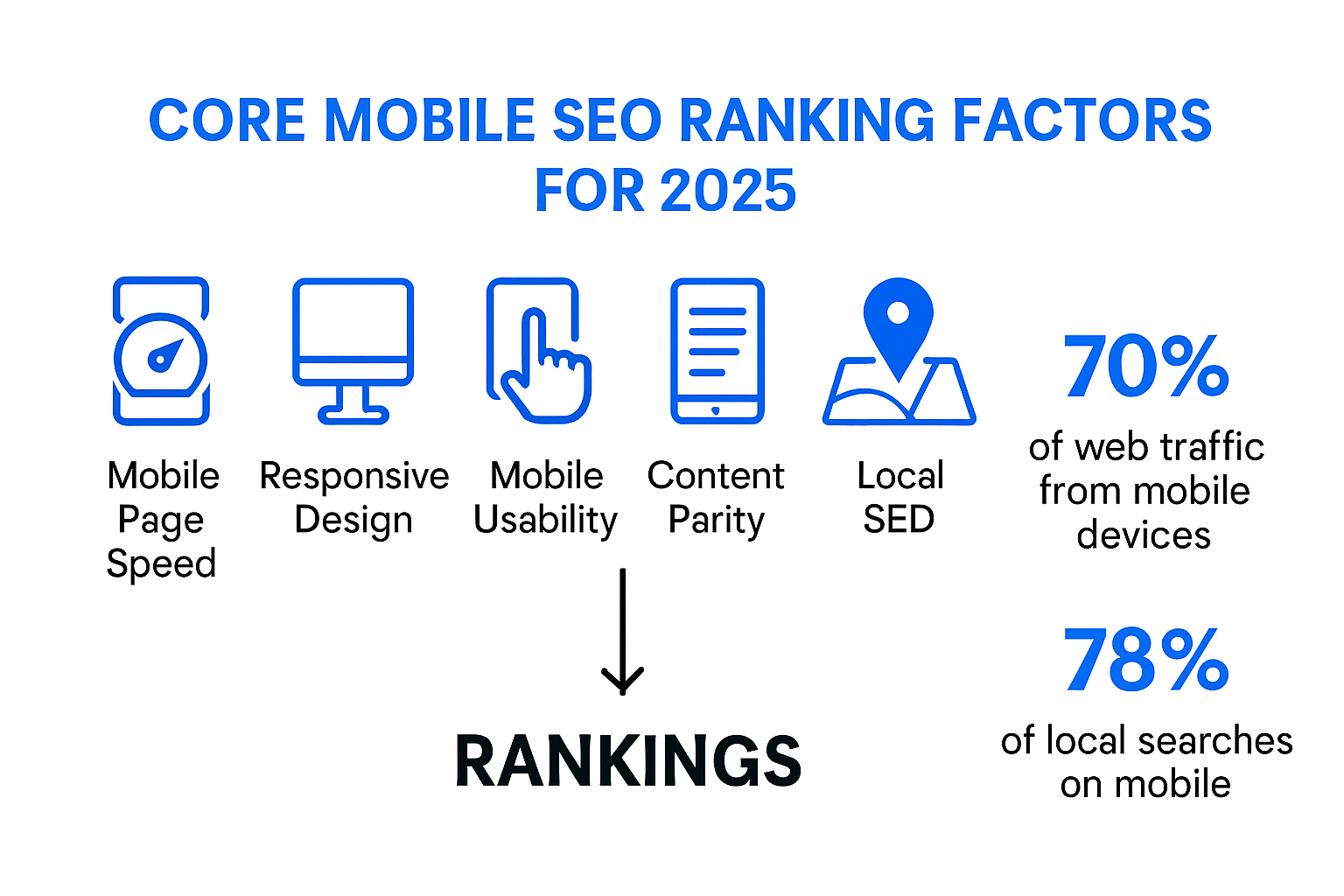Mobile SEO has officially taken center stage with search engines now making mobile performance their top priority. In 2025, over 65 percent of all website traffic comes from mobile devices, and even a split-second lag can drop conversions by double digits. Most people expect to lose out if their pages load slowly or their design looks off on a phone. Think mobile-first indexing is just another technical update? The real power shift is that your mobile site now defines your entire search presence, not your desktop. Every detail counts and every millisecond makes a difference.
Table of Contents
- Understanding Mobile Seo And Ranking Factors
- Optimizing Site Speed And Mobile Usability
- Mobile-First Indexing: Best Practices For 2025
- Tracking And Improving Mobile Seo Performance
Quick Summary
| Takeaway | Explanation |
|---|---|
| Mobile user experience is crucial for ranking. | Search engines prioritize websites that load quickly and offer seamless navigation on mobile devices. |
| Optimize for mobile-first indexing. | Ensure your website’s mobile version is robust and contains identical core content to the desktop version. |
| Site speed impacts user engagement significantly. | Slow-loading sites can lead to higher bounce rates and lower conversions; every millisecond counts. |
| Utilize key performance metrics effectively. | Monitor metrics like mobile bounce rate and conversion rate to adapt optimization strategies accordingly. |
| Implement continuous performance tracking. | Treat mobile SEO as an evolving strategy, regularly updating based on user behavior and analytics insight. |
Understanding Mobile SEO and Ranking Factors
Mobile search optimization has become a critical strategy for businesses seeking digital visibility. The landscape of mobile search has transformed dramatically since Google’s pivotal ‘Mobilegeddon’ algorithm update, which fundamentally reshaped how websites are ranked on mobile devices.
Core Mobile Search Ranking Dynamics
Search engines now prioritize mobile performance as a primary ranking factor. Mobile user experience determines whether a website will succeed or struggle in search results. This means your website must load quickly, display correctly, and provide seamless navigation across various mobile devices and screen sizes.
Performance metrics like page speed, mobile responsiveness, and content accessibility directly impact search rankings. Research analyzing SERP features reveals that websites optimized for mobile receive significantly higher click-through rates compared to non-optimized platforms.

Technical Elements Driving Mobile SEO Success
Effective mobile SEO requires a comprehensive approach addressing multiple technical dimensions. Key considerations include:
- Responsive Design: Websites must automatically adjust layout and content for different screen sizes
- Page Load Speed: Mobile users expect rapid content delivery
- Touch-Friendly Navigation: Intuitive interfaces that work seamlessly on touchscreens
Local search optimization adds another critical layer. Local search engine optimization factors like prominence, relevance, and geographic proximity significantly influence mobile search rankings, especially for businesses targeting regional audiences.
Understanding these intricate ranking factors allows SEO professionals to develop strategic approaches that align with search engine algorithms. By prioritizing mobile user experience and technical performance, websites can improve their visibility and attract more organic traffic.
For deeper insights into optimizing your digital strategy, learn more about advanced SEO techniques that can elevate your mobile search performance.
Optimizing Site Speed and Mobile Usability
Mobile site performance represents a critical battleground for digital success in 2025. Search engines and users alike demand lightning-fast, seamless experiences that deliver information instantaneously. Slow loading times can decimate user engagement and sabotage search rankings.
Performance Metrics that Matter
Website speed is no longer a luxury but a fundamental requirement. According to NIST digital experience guidelines, user interface performance directly correlates with overall digital experience quality. Google’s Core Web Vitals provide the benchmark for mobile site performance, measuring key indicators like:
To help you easily compare the most important performance metrics for mobile SEO mentioned in this section, the following table summarizes their definitions and significance.
| Metric | What It Measures | Why It Matters |
|---|---|---|
| Largest Contentful Paint (LCP) | Speed of main content load | Indicates perceived load speed for users |
| First Input Delay (FID) | Responsiveness to user interactions | Reflects user experience and interaction readiness |
| Cumulative Layout Shift (CLS) | Visual stability during page rendering | Affects perceived quality; fewer unexpected shifts |
- Largest Contentful Paint (LCP): How quickly main content loads
- First Input Delay (FID): Responsiveness to user interactions
- Cumulative Layout Shift (CLS): Visual stability during page rendering
Technical Optimization Strategies
Successful mobile optimization requires a multi-pronged approach. Compression techniques, minimized code, and strategic content delivery networks (CDNs) can dramatically improve site speed. Implementing browser caching, reducing server response times, and optimizing image sizes are foundational techniques for enhancing mobile performance.
Modern web development demands a holistic view of mobile usability. Responsive design must go beyond mere visual adaptation. Touchscreen-friendly interfaces, intuitive navigation, and content that scales seamlessly across devices are non-negotiable requirements.
Mobile users are notoriously impatient. Research indicates that websites losing even a fraction of a second in loading time can see significant drops in user engagement and conversion rates. Every millisecond counts in the competitive digital ecosystem.
Mobile optimization is not just about speed—it is about creating frictionless user experiences that anticipate and fulfill user needs instantly. By focusing on performance metrics, implementing cutting-edge optimization techniques, and prioritizing user experience, websites can transform their mobile presence.

Discover advanced SEO performance strategies that can help you stay ahead in the rapidly evolving digital landscape.
Mobile-First Indexing: Best Practices for 2025
Mobile-first indexing represents a fundamental shift in how search engines evaluate and rank websites. According to Google’s official documentation, this approach prioritizes mobile versions of websites as the primary source for content indexing and ranking.
Understanding Mobile-First Indexing Requirements
In 2025, mobile-first indexing is no longer optional but a critical strategy for digital visibility. Search engines now exclusively use the mobile version of a website’s content to assess its relevance, ranking, and overall search performance. This means that websites must ensure their mobile platforms are not just responsive, but comprehensive and fully optimized.
Below is a checklist table summarizing the core technical requirements for successful mobile-first indexing, based on the best practices outlined in this section.
| Requirement | Description | Present on Your Site? |
|---|---|---|
| Content Parity | Identical core content on mobile and desktop | [ ] |
| Responsive Design | Layout adapts seamlessly to all device types | [ ] |
| Performance Optimization | Fast loading times and smooth user experience | [ ] |
| Structured Data Included | Markup is present and accurate on mobile | [ ] |
| Full Resource Access for Bots | Googlebot can render all mobile content | [ ] |
Search Engine Land research highlights key considerations for successful mobile-first implementation:
- Content Parity: Mobile and desktop versions must contain identical core content
- Responsive Design: Seamless adaptation across different device types
- Performance Optimization: Fast loading times and smooth user experience
Strategic Implementation Techniques
Successful mobile-first indexing requires a holistic approach. Websites must verify that all critical elements translate perfectly to mobile platforms. This includes structured data, metadata, images, and interactive features. Google Search Central Blog recommends allowing complete access to mobile page resources, ensuring Googlebot can fully render and understand mobile content.
Technical considerations extend beyond mere visual compatibility. Page speed, mobile-specific user experience, and content accessibility become paramount. Websites must implement advanced techniques like lazy loading, compressed image formats, and streamlined navigation to meet evolving mobile search standards.
Mobile-first indexing is more than a technical requirement—it is a fundamental reimagining of digital content strategy. Organizations must view their mobile platform not as a secondary consideration, but as the primary interface for user engagement and search visibility.
Explore advanced SEO optimization strategies to stay ahead in the mobile-first digital ecosystem.
Tracking and Improving Mobile SEO Performance
Mobile SEO performance is a dynamic landscape requiring continuous monitoring and strategic optimization. Search Engine Land’s comprehensive guide emphasizes the critical importance of establishing a robust tracking and improvement framework that goes beyond traditional metrics.
Performance Measurement Tools and Metrics
Successful mobile SEO tracking demands a multi-dimensional approach. Key performance indicators extend far beyond basic website traffic. Professionals must leverage advanced analytics tools that provide granular insights into mobile user behavior, engagement patterns, and conversion dynamics.
Critical metrics for mobile SEO performance include:
- Mobile Bounce Rate: Indicates user experience and content relevance
- Page Load Speed: Directly impacts user engagement and search rankings
- Mobile Conversion Rate: Measures the effectiveness of mobile optimization strategies
Strategic Optimization Techniques
Search Engine Journal research highlights the significance of responsive web design and dynamic serving as foundational optimization techniques. These approaches enable websites to adapt seamlessly across diverse device types, screen sizes, and user interactions.
Local SEO plays a crucial role in mobile performance tracking. The AJC Center’s SEO encyclopedia underscores the importance of location-based optimization, emphasizing that mobile searches often have strong local intent.
Mobile SEO is not a static strategy but a continuous process of adaptation and refinement. Successful organizations treat mobile performance tracking as an ongoing initiative, constantly analyzing data, identifying improvement opportunities, and implementing strategic adjustments.
Advanced tracking requires a holistic approach that combines technical analysis, user experience evaluation, and strategic optimization. By implementing comprehensive monitoring tools and maintaining a proactive optimization mindset, businesses can transform their mobile digital presence.
Discover advanced techniques for SEO performance optimization to elevate your mobile search strategy.
Frequently Asked Questions
What is mobile SEO optimization?
Mobile SEO optimization refers to the process of enhancing your website to improve its performance and usability on mobile devices. This includes ensuring fast load times, responsive design, and a seamless user experience to boost search rankings on mobile search engines.
Why is mobile-first indexing important for SEO in 2025?
Mobile-first indexing is crucial because search engines primarily use the mobile version of websites for indexing and ranking. A well-optimized mobile site can significantly impact visibility and search performance, making it essential for businesses to prioritize their mobile web design and content.
How can I improve my site’s mobile loading speed?
To improve your site’s mobile loading speed, consider compressing images, enabling browser caching, minimizing JavaScript and CSS files, and employing content delivery networks (CDNs). These techniques help reduce load times, enhancing user experience and positively affecting search rankings.
What performance metrics should I track for mobile SEO?
Key performance metrics to track for mobile SEO include mobile bounce rate, page load speed, and mobile conversion rate. Monitoring these metrics can provide insights into user behavior and highlight areas for optimization in your mobile strategy.
Turn Mobile SEO Challenges Into Growth Opportunities With RankAligner
Is your mobile site struggling to keep up with search engine demands and real user expectations? If you worry about site performance, duplicate rankings, or content getting buried by technical issues like keyword cannibalization, you are not alone. The pressure to achieve better mobile speed, flawless mobile-first indexing, and competitive search visibility is greater than ever. But fixing these pain points does not have to be complicated.
Now is your chance to solve these mobile SEO problems effectively. RankAligner is trusted by consultants and agencies who need real solutions for maximizing search performance and resolving content cannibalization issues. Visit RankAligner to discover how our platform helps you uncover hidden SEO gaps and reclaim your rankings in today’s mobile-first world. Take control and elevate your mobile search results right now.
Recommended
- The Final Guide to Content Cannibalization in SEO (& How to Avoid)
- 15 Winning Hacks to Avoid Keyword Cannibalization Like a Pro
- How to Exactly Fix Keyword Cannibalization to Improve Website SEO- Rank Aligner
- 10 Keyword Cannibalization Mistakes That Are Killing Your SEO
- Optimizing Mobile Landing Pages: Proven Strategies for 2025

